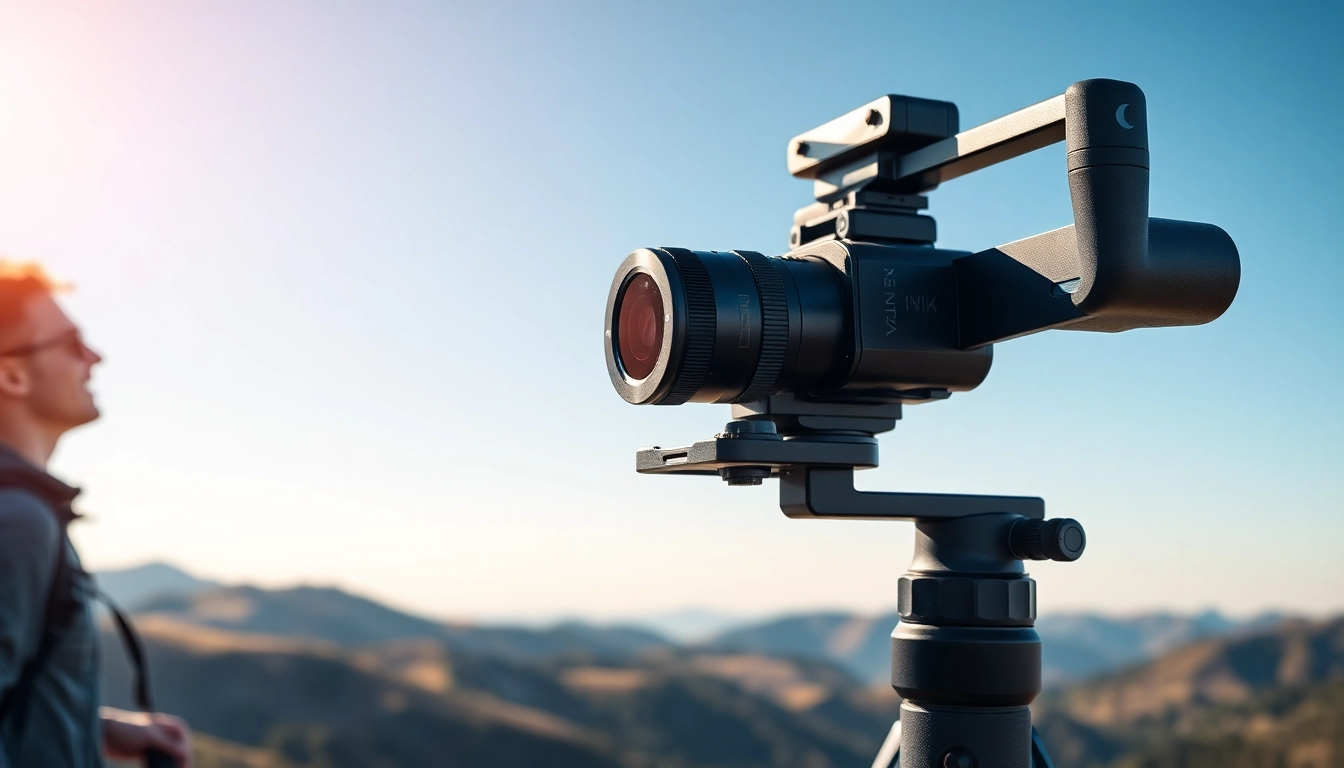Understanding the Basics of Gimbal Camera Technology
What is a Gimbal Camera?
A gimbal camera is designed to provide a stable filming platform for various types of cameras, effectively eliminating unwanted motion, shakes, and jitters during video recording. Unlike a standard tripod, a gimbal employs a sophisticated mechanical system or motors to maintain camera orientation in three-dimensional space. Typically offering three axes of stabilization—pitch, roll, and yaw—a gimbal allows for smooth panning, tilting, and tracking of moving subjects. This stabilizing technology has made gimbals indispensable tools for filmmakers, vloggers, and content creators looking to produce professional-quality footage, even in dynamic environments.
Key Features and Benefits of Gimbal Cameras
Gimbal cameras come equipped with several advanced features designed to enhance the filming experience. Some of the most notable benefits include:
- Smooth Footage: The primary advantage of using a gimbal camera is the ability to achieve incredibly smooth, cinematic shots, regardless of the shooting conditions.
- Versatility: Gimbal systems support a wide range of cameras, including DSLRs, mirrorless models, smartphones, and action cameras, making them suitable for various creative projects.
- Improved Control: Many gimbals feature intuitive controls, allowing users to fine-tune settings, control movements, and operate the device with ease.
- Lightweight Designs: Most gimbal cameras are constructed from lightweight materials, making them portable and easy to handle during shoots.
- Battery Life: Many modern gimbals come with extended battery life, allowing for longer shooting sessions without interruption.
Types of Gimbal Cameras Available in the Market
The market is filled with a variety of gimbal cameras, each tailored for different filming needs. Here are the main types:
- Smartphone Gimbals: Compact and lightweight, these gimbals are specifically designed for smartphones, ideal for casual vlogging or social media content.
- DSLR Gimbals: Designed for heavier setups, DSLR gimbals provide robust stabilization for professional filmmaking, accommodating larger rigs and lenses.
- Mirrorless Gimbals: Similar to DSLR versions but optimized for mirrorless cameras, offering a balance of stability and portability.
- Action Camera Gimbals: Tailored for action cameras, these gimbals often feature rugged construction, perfect for extreme sports and adventure filmmaking.
Choosing the Right Gimbal Camera for Your Needs
Factors to Consider When Selecting a Gimbal Camera
When shopping for a gimbal camera, several factors should influence your decision:
- Camera Compatibility: Ensure the gimbal you choose is compatible with your camera model and accessories.
- Weight Capacity: Each gimbal has a weight limit; check this to avoid issues with balance and stabilization.
- Battery Life: Consider how long you’ll be filming and choose a gimbal with sufficient battery capacity to meet your needs.
- Tracking Features: Features such as smart tracking can enhance the usability of your gimbal, allowing for dynamic movement even with moving subjects.
- Portability: If you plan to travel with your gimbal, opt for a lightweight and compact model for ease of transport.
Best Use Cases for Different Gimbal Cameras
Understanding application scenarios helps in selecting the most suitable gimbal camera:
- Vlogging and Social Media Content: Smartphone gimbals deliver the stability needed for capturing engaging content on the go.
- Professional Filmmaking: DSLR and mirrorless gimbals are essential for creating high-quality, cinematic films, where stability matters the most.
- Adventure and Sports: Action camera gimbals withstand harsh conditions, ideal for capturing footage while biking, skiing, or participating in other activities.
- Travel Filmmaking: Lightweight and compact gimbals are perfect companions for travelers, allowing them to capture memorable moments without added bulk.
Budgeting for Your Gimbal Camera Purchase
Determining a budget can simplify your gimbal camera selection process. Prices vary significantly based on features, build quality, and brand reputation. Here’s a general breakdown:
- Entry-Level Gimbals: Typically range from $50 to $200, suitable for casual users or beginners.
- Mid-Range Gimbals: Priced between $200 and $600, offering more stability and advanced features for amateur filmmakers.
- Professional Gimbals: These start from around $600 and can exceed $1,500, designed for serious filmmakers needing top-tier performance.
Techniques for Effective Filmmaking with Gimbal Camera
Steady Shot Techniques Using Gimbal Cameras
To maximize your gimbal’s potential, employing steady shot techniques can create visually stunning content:
- Follow Mode: Use this mode to track moving subjects effortlessly, keeping them centered in the frame.
- POV (Point of View) Shots: Mimic the perspective of a character or subject, providing viewers with an immersive experience.
- Low and High Angles: Modify your angle to create dynamic visuals; low angles enhance drama, while high angles provide context.
- Virtual Dolly Shots: Move smoothly along a horizontal line to mimic dolly shots, enhancing the production value of your footage.
Creative Angles and Movements with Gimbal Cameras
Gimbal cameras enable filmmakers to experiment with creative angles and movements:
- Crane Shots: Use a gimbal to achieve vertical sweeps, giving a dramatic, towering perspective.
- 360-Degree Shots: Embrace full rotation movements to capture the surroundings or enhance storytelling.
- Reveal Shots: Begin with a close-up and gradually reveal the full scene, generating a sense of discovery.
- Tracking Shots: Follow subjects as they move, ensuring smooth footage even in busy environments.
Editing Footage Captured with Gimbal Cameras
Post-production is where gimbal footage truly comes to life with editing techniques:
- Stabilization Software: While gimbals greatly reduce shakes, additional software stabilization can offer extra smoothness.
- Cutting Between Angles: Utilize various shots captured to maintain visual interest and rhythm in your editing.
- Color Grading: Enhance the visual aesthetics of your footage with color grading techniques to create mood.
- Tightening Edits: Review your footage critically, cutting out unnecessary moments to retain viewer engagement.
Maintenance and Care for Your Gimbal Camera
Cleaning and Storing Your Gimbal Camera
Taking care of your gimbal camera is crucial for longevity and performance:
- Regular Cleaning: Use a soft cloth to wipe down the body of the gimbal, and avoid any abrasive materials that could scratch.
- Protecting the Gimbal: When not in use, store your gimbal in a protective case to shield it from dust and accidental damage.
- Regular Checks: Periodically inspect the gimbal for signs of wear or mechanical issues to address them promptly before they escalate.
Common Issues and Troubleshooting Tips
Knowing how to troubleshoot common gimbal issues can save time and frustration:
- Drifting: If your gimbal drifts, recalibrate it according to the manufacturer’s instructions.
- Inconsistent Stabilization: Ensure batteries are freshly charged and gimbal settings are correctly configured.
- No Response: If the gimbal doesn’t respond, check for firmware updates or restart the device.
Upgrading Components for Optimal Performance of Gimbal Cameras
Enhancing your gimbal camera experience often involves upgrading components:
- Camera Upgrades: As technology advances, using a newer camera can improve overall performance.
- Firmware Updates: Keep your gimbal’s firmware up to date to access new features and improvements.
- Accessory Compatibility: Exploring additional accessories like follow focus systems can enhance your shooting capabilities.
The Future of Gimbal Camera Technology
Emerging Trends in Gimbal Cameras
The future of gimbal camera technology promises exciting innovations that can further benefit filmmakers:
- Advanced AI Integration: Implementing artificial intelligence for features such as automated tracking can elevate user experience.
- Compact Designs: The trend towards lightweight, folding gimbals enhances portability without sacrificing performance.
- Smartphone Integration: More gimbals are being designed to work seamlessly with smartphone apps, offering enhanced control and customization.
Integrating Smart Features in Gimbal Cameras
Many gimbal manufacturers are integrating smart features that expand functionality:
- Gesture Control: Users can control gimbal movements with simple hand gestures, making operation more intuitive.
- Bluetooth Connectivity: Wireless communication capabilities allow for easy connection to smartphones for direct control and monitoring.
- Live streaming Integration: Built-in functionality for live streaming enhances the gimbal’s appeal for content creators.
Future Applications of Gimbal Camera Technology in Filmmaking
As the capabilities of gimbal cameras continue to evolve, so do their applications:
- Virtual Reality: Gimbals are becoming integral to virtual reality filming, capturing seamless footage for immersive experiences.
- Documentaries and Events: Their versatility and stabilization features lend themselves well to documentary filmmaking, capturing candid moments with ease.
- Interactive Experiences: Gimbals can be utilized in interactive media and installations, offering unique perspectives.



